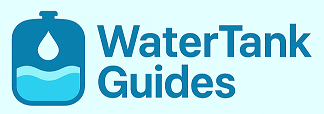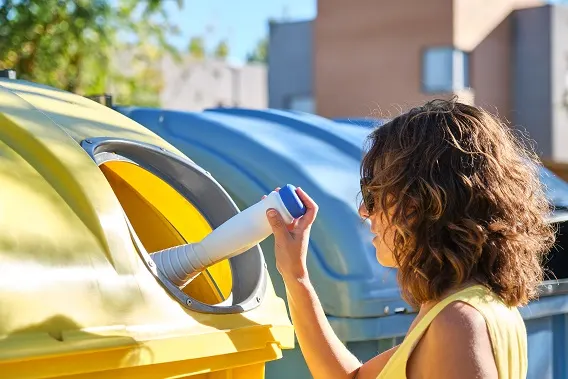If you’re wondering how to clean a plastic water tank in your house without chemicals, the simplest and safest way is to drain the tank, scrub the walls with a soft brush, rinse with clean water, and use natural agents like baking soda or vinegar to remove dirt and bacteria.
This process takes little time, needs no harsh products, and keeps your family’s water supply fresh and safe.
Why Avoid Chemicals When Cleaning a Water Tank
Most people reach for bleach or chlorine when cleaning a tank, but these substances can leave harmful residues inside the tank. Over time, that residue can affect the taste and safety of drinking water. Chemical traces may also react with plastic and cause discoloration or odors.
Choosing chemical-free tank cleaning is better for your health and the environment. It ensures that your drinking water stays natural and toxin-free, while protecting the inner surface of your plastic water tank from damage. This approach is part of eco-friendly water tank maintenance, which is safer for homes with children, pets, or sensitive individuals.
According to the World Health Organization (WHO) (2024 report), improper cleaning and chemical residues in stored household water can promote bacterial growth, including E. coli, if tanks aren’t cleaned at least once every three months.
Signs Your Tank Needs Cleaning
A plastic water tank usually needs a deep clean every few months, but sometimes you can tell it’s due earlier. The most common signs include:
- Cloudy or discolored water
- A musty or unpleasant odor
- Algae or slime on the walls
- Sediment at the bottom
- Slower water flow from taps
Ignoring these signs can lead to bacteria growth and poor water quality. Early cleaning not only maintains hygiene but also extends the life of your domestic water tank.
What You’ll Need
To start your manual tank cleaning process, gather these basic tools:
A soft scrub brush or mop, a clean bucket, a mug or scoop, a small amount of baking soda or white vinegar, a microfiber cloth, and plenty of fresh water.
You don’t need expensive equipment or detergents—just simple, non-toxic cleaning materials that are safe for everyday use.
These items will help you perform eco-safe tank washing effectively, without introducing any chemical residue.
Step-by-Step Guide to Cleaning Without Chemicals
Cleaning a plastic water tank the natural way is straightforward if you follow a proper sequence.
Start by turning off the water supply and disconnecting any electric pump to ensure safety. Then, open the outlet valve and drain all water completely. Once empty, use a mug or small container to remove leftover water and debris from the base.
Next, take a clean brush with a long handle and gently scrub the inner walls and bottom. Focus on corners and joints where sediment and algae often collect. Avoid using metal brushes or anything that could scratch the plastic surface. Scratching can encourage bacteria buildup later.
Once scrubbing is complete, make a paste using baking soda and water. This natural tank disinfectant works well for removing stains or slippery areas. Spread the paste on the walls, leave it for about 10–15 minutes, and then rinse thoroughly with clean water.
If you prefer a liquid cleaner, mix one part white vinegar with three parts water and use it to rinse the interior. Vinegar is a powerful natural water tank cleaning method that eliminates odor and kills germs safely. Finally, rinse the tank several times until all residue is gone, then wipe the inside with a clean cloth and allow it to air-dry before refilling.
This DIY water tank cleaning approach ensures a chemical-free tank cleaning routine that’s both simple and sustainable.
For a detailed guide on general tank cleaning methods, check out our step-by-step article on how to clean your water tank at home
Natural Alternatives You Can Use
When it comes to cleaning water storage tanks naturally, there are several household products that work surprisingly well.
Baking soda neutralizes odors and removes grease or organic stains. Vinegar acts as a mild disinfectant, ideal for eliminating algae. Lemon juice has antibacterial properties and leaves a fresh scent. For stubborn areas, a mixture of baking soda and vinegar can create a gentle foaming action that lifts dirt easily.
According to the U.S. Environmental Protection Agency (EPA), maintaining clean storage containers and avoiding chemical additives supports safer, long-term water quality in domestic systems.
These eco-friendly cleaning methods are safe for drinking water tanks, protect your family’s health, and are much kinder to the environment than synthetic cleaners.
How Often Should You Clean a Plastic Water Tank
The frequency of cleaning depends on usage, climate, and water quality.
For most homes, a water tank cleaning frequency of every three to six months is ideal. Areas with hard water or frequent dust should consider quarterly cleaning.
Regular maintenance helps prevent algae, sediment, and bacteria growth. Keeping a consistent natural cleaning routine also reduces bad odors and keeps water clear and safe.
Common Mistakes to Avoid
Even when using chemical-free cleaning, people often make small errors that reduce effectiveness. Some use rough tools that scratch the tank surface; others forget to rinse properly or close the lid afterward. Neglecting to dry the tank completely before refilling can cause moisture buildup and bacterial growth.
Avoid using leftover soap or detergents from other household cleaning since they can contaminate water.
Lastly, never forget to disconnect electrical components before cleaning to prevent accidents.
Safety and Hygiene Tips
Always prioritize safety during your manual cleaning process. Wear gloves to protect your hands, and keep children and pets away during the task. Use only clean water and dedicated tools—don’t reuse brushes that have touched other chemicals. Once cleaning is finished, make sure the tank lid fits tightly to prevent dust and insects from entering.
These small precautions ensure safe home water cleaning and maintain healthy water quality throughout your household.
Benefits of Cleaning Without Chemicals
Cleaning your tank naturally offers several important advantages. It guarantees healthy drinking water, prevents chemical residues, and protects the environment. Natural methods are gentle on plastic water tank surfaces, preventing cracks and discoloration.
They’re also cost-effective—no need to buy expensive detergents or disinfectants.
Regular chemical-free tank cleaning supports sustainable living and promotes green home maintenance, ensuring safe water for your entire family.
Maintaining a Clean Water Tank
Once your tank is spotless, it’s important to keep it that way. Check the tank cover regularly to make sure it’s sealed tightly. Prevent debris from entering by installing a fine mesh filter on inlet pipes. Avoid storing the tank in direct sunlight if possible, since sunlight encourages algae growth.
Keep the surroundings clean, and note your last cleaning date so you can schedule the next one on time. Consistency is key in domestic water tank care, and preventive maintenance saves you effort in the long run.
Frequently Asked Questions
1. Is baking soda safe for cleaning a drinking water tank?
Yes, baking soda is completely safe. It acts as a non-toxic cleaning solution that removes odor and dirt without affecting water quality.
2. Can vinegar remove algae from a plastic tank?
Absolutely. Vinegar is a natural disinfectant that kills algae and bacteria without introducing chemicals.
3. How often should I clean my water tank at home?
Ideally every three to six months, depending on water usage and environment.
4. What’s the best way to dry the tank after cleaning?
Wipe the inside with a clean cloth and leave the lid open for 15–30 minutes until fully dry.
5. How can I prevent algae in the future?
Keep the lid closed tightly and clean the tank regularly using natural cleaning methods like vinegar or lemon.
Conclusion
Learning how to clean a plastic water tank in your house without chemicals is one of the best ways to keep your family’s water supply healthy and safe.
By using simple materials like baking soda, vinegar, and clean water, you can easily remove dirt, sediment, and bacteria without relying on harsh substances.
This eco-friendly water tank maintenance method saves money, protects the environment, and ensures pure water for daily use.
Start your chemical-free tank cleaning routine today—your health, your tank, and the planet will all benefit.
Ethan Wells is the author of Water Tank Guides, a blog focused on practical tips for water tank cleaning, maintenance, and installation. His mission is to help readers keep their water clean, safe, and their tanks long-lasting through simple, easy-to-follow guides.

